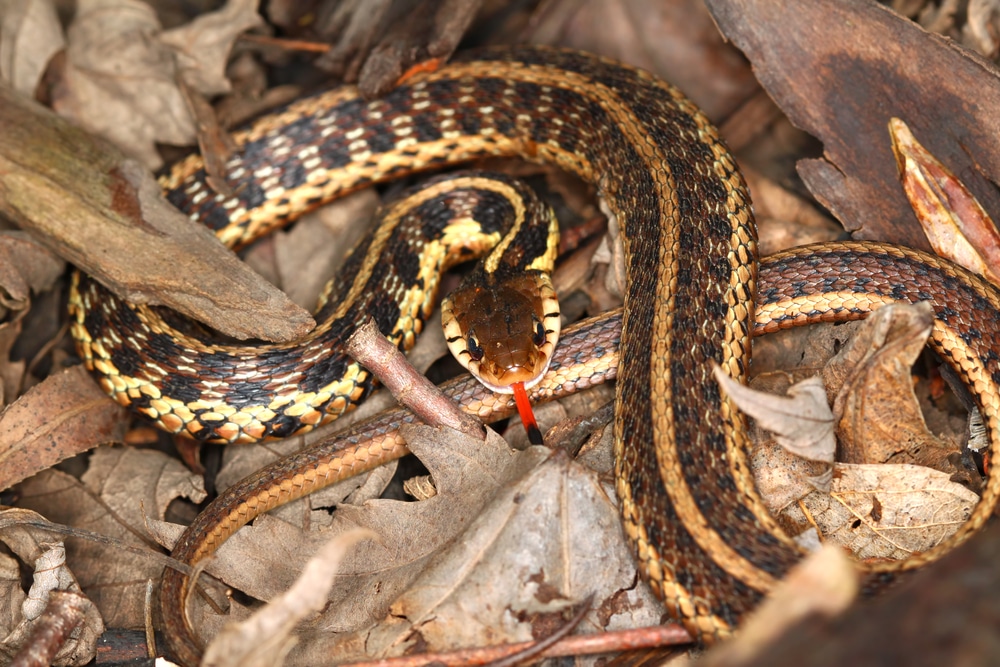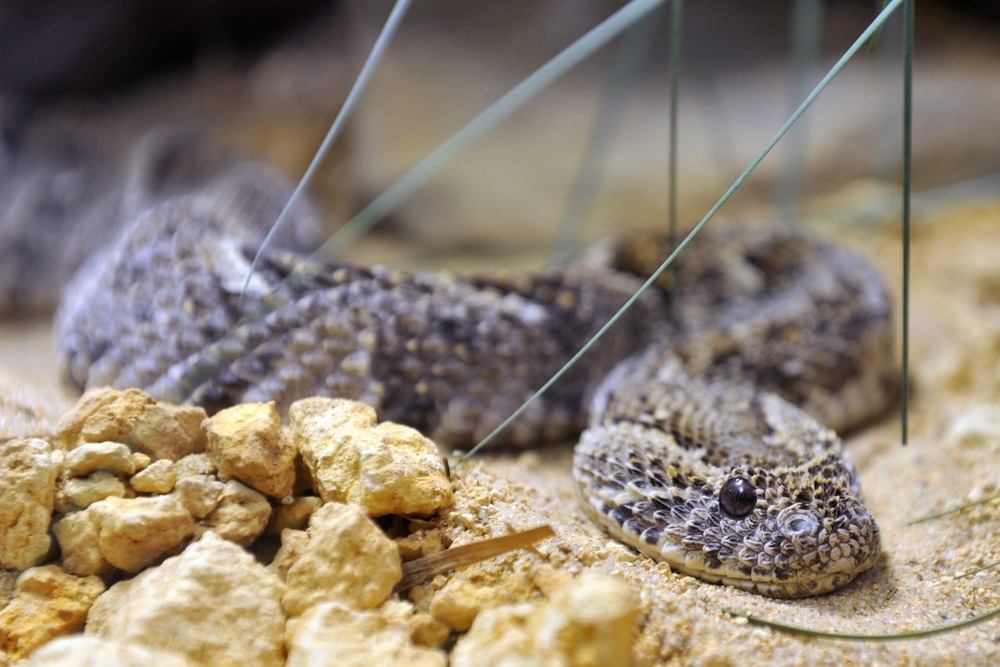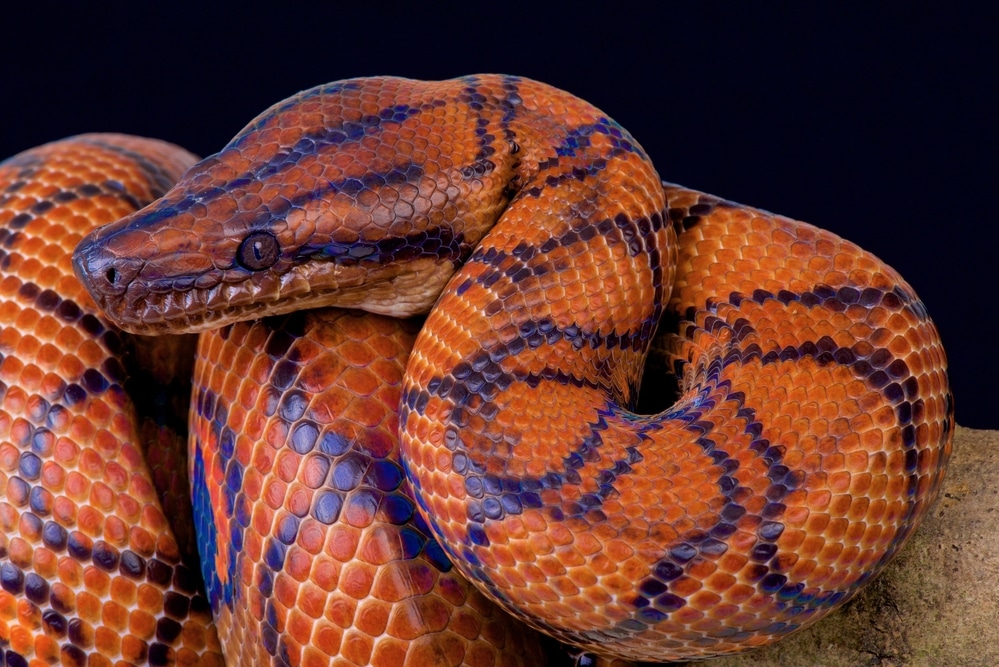Snakes are a diverse group of animals. They may all have more-or-less similar body plans, but there are considerable differences across the 3,600 or so species currently recognized.
Some of these differences relate to size, diet or lifestyle, but one of the most interesting ways in which snake species vary relates to reproduction – some snakes reproduce by depositing eggs, but others give live birth. This catches many people by surprise, as conventional wisdom often contends that all reptiles lay eggs.

We will identify some of the most noteworthy snakes that give live birth below and try to help owners decide whether live-bearing snakes make better pets than their egg-laying counterparts.
But first, we need to examine some of the technical details of snake reproduction, so you can better understand the process.
Quick Navigation
Oviparity, Ovoviviparity and Viviparity
Before diving into the details of snake reproduction, we must first define a few important terms.
- Oviparity / oviparous – Oviparity refers to animals that reproduce by depositing eggs. Most snakes are oviparous.
- Viviparity / viviparous – Viviparity refers to animals that give live birth. In these cases, there is some exchange of resources and waste products between the mother and offspring. In mammals, this occurs via a structure called the placenta.
- Ovoviviparity / ovoviviparous – Ovoviviparity is a poorly defined term, which is not used as commonly by modern scientists. It essentially refers to animals who develop inside non-shelled eggs inside the mother. The offspring typically “hatch” right after birth.
Because it is hard to draw a line between ovoviviparity and viviparity, the former term has largely fallen out of use. Nevertheless, you may see it from time to time.
Accordingly, casual keepers can ignore these distinctions, and simply divide snakes into two primary groups: those who give live birth and those who lay eggs.
Some Species of Snakes That Give Live Birth
Below, we discuss some of the snakes that give live birth. As you will see, there are a few characteristics that are common among these species.
Natricines

Most snakes of the subfamily Natricinae – a group that includes garter, ribbon and water snakes – give live birth. These snakes are native to portions of North and Central America, Europe, Asia and Africa. Many of these species live near water and some are found in areas with relatively cool climates.
Vipers and Pit Vipers

Almost all vipers and pit vipers give live birth, although there are a few key exceptions, such as bushmasters (Lachesis). Vipers and pit vipers are found in North, Central and South America, as well as Europe, Africa and Asia. They are all venomous creatures, and a few species live in areas with very cool climates.
Boas and Their Relatives

All boas and their relatives except the enigmatic Calabar boa (Calabaria reinhardtii) give live birth. This includes boa constrictors, rainbow boas, tree boas, sand boas and anacondas. These snakes are primarily found in Central and South America, but a few are found in Africa and Asia.
Some Elapids

Most elapids – a group that includes cobras, coral snakes, kraits and their relatives – reproduce by laying eggs. However, there are a number of exceptions in the group. Death adders (Acanthophis), for example, give live birth, as do all sea snakes. These species are found all over the world, including every major continent aside from Antarctica.
What Are the Benefits of Giving Live Birth?
Oviparity is thought to be the ancestral reproductive method for snakes. However, scientists suspect that there are several benefits of giving live birth, which explains why the practice has evolved in many different snake lineages. A few of the most important benefits are discussed below.
Snakes That Give Live Birth Can Protect Their Developing Young
Many predators will gladly consume snake eggs, so snakes that are able to protect their eggs or developing young enjoy an advantage.
This is thought to be the reason that many live-bearing snakes are either venomous or reach large sizes, as both of these characteristics improve a snake’s chance of defending her developing offspring.
Snakes That Give Live Birth Can Keep Their Eggs Warmer
Snakes are ectothermic creatures, meaning they must absorb warmth from their surroundings. This is why snakes often bask in the sun when temperatures are low. But their eggs or developing young are also ectothermic and must be kept suitably warm to develop properly.
Some egg-laying species (including, most notably, many pythons), get around this issue by wrapping around their egg clutch and “twitching” to generate heat for the eggs. Others simply deposit their eggs in a relatively warm location and hope for the best.
But live-bearing snakes carry their developing young with them everywhere. This means they can simply crawl out into the sun to warm the young snakes inside their bodies. This is thought to explain the fact that many live-bearing snakes live in places with cool climates. In fact, most of the species that live at extremely high latitudes – such as European adders (Vipera berus) give live birth.
Snakes That Give Live Birth Can Live in Areas Where Egg-Laying Species Can’t
Some snakes live in aquatic habitats, which would make egg-laying a challenging method of reproduction. Snake eggs that become wet are rarely viable.
Accordingly, many species that live in or around water give live birth. This includes many semi-aquatic species, such as garter and water snakes, as well as species like sea snakes, who spend their entire lives in the water.
Should You Pick a Snake that Gives Birth or Lays Eggs?
Now that you understand the different ways in which snakes reproduce, it makes sense to decide whether this should influence your decision-making process when picking out a new snake. Generally speaking, the method by which a snake species reproduces is not a terribly important criterion to consider, but there are situations in which you should give thought to the issue.
Keepers Who Want a Pet Snake
Keepers who simply want a pet snake and have no intentions of breeding the animal should almost always opt for a male specimen. Male snakes are generally more numerous in the marketplace, as breeders often keep many of the female snakes that they produce for themselves. This keeps the price of male snakes lower in most cases.
In such cases, it does not really matter if you choose a species that gives live birth or lays eggs. You can simply make your decision based on the snake’s husbandry needs, appearance and personality, among other things.
But because some female snakes may produce a clutch of (infertile) eggs even if not kept in the company of a male, and this can create a very small risk of complications, it may be wise for keepers interested in keeping a female snake to choose a live-bearing species, who is less likely to suffer from dystocia (egg binding).
Again, the relative risk of egg-laying problems in a female snake are pretty low, but if you are trying to choose between, say, a female ball python and a female boa constrictor, the latter is probably less likely to experience reproductive issues.
Keepers Who Want to Breed Their Snakes
While a snake’s method of reproduction is only a minor consideration for keepers looking for a pet, it can be a very important consideration for those interested in breeding projects. Unfortunately, there is no quick-and-easy way to make this decision.
At first glance, it may seem that live-bearing snakes are a better choice. After all, if you try to breed an egg-laying species, you will have to purchase or build an incubator and take care of the eggs for two to three months.
For that matter, some egg-laying species, including most pythons, will wrap around their egg clutch. This means you’ll have to go in and remove the (often defensive) mother from the clutch without allowing her to damage the eggs in her attempts to drive away the predator (you).
Removing and incubating eggs can be challenging for some keepers, so it seems preferable to avoid egg-laying species whenever possible.
But live-bearing species present challenges too – they are just different challenges.
While live-bearing snakes eliminate the need for their keeper to incubate the eggs, the “eggs” still require incubation and care. The mother just handles this for you, which can take a toll on her health.
Live-bearing snakes hold their offspring inside their bodies for about twice as long as egg-laying species do. And this means that live-bearing snakes often take much longer to recover and replenish their fat reserves after a breeding cycle than egg-laying species do. Many will even require a full year of rest before they’re capable of producing more young.
Also, while you would need to be very careful with eggs during the incubation process, you’ll have to be very careful with the mother when breeding live-bearing species. This can be very challenging with large, potentially defensive animals, who don’t realize you mean them no harm.
Ultimately, you will simply need to decide whether you would prefer to deal with the challenges egg-laying species present, or you’d rather deal with those that live-bearing snakes present.
Conclusion
It’s certainly interesting to compare and contrast the different reproduction patterns snake species exhibit, but remember that these differences will have implications for keepers too. So, be sure to carefully consider these factors before choosing your next pet or breeding project.